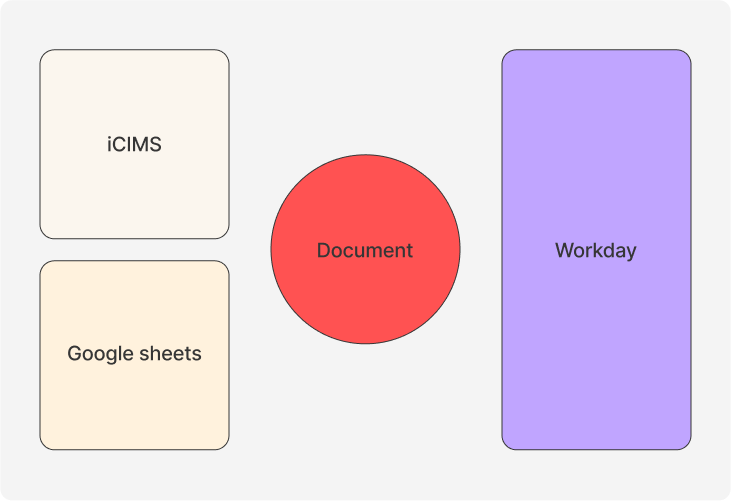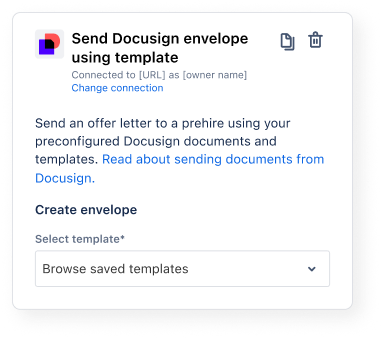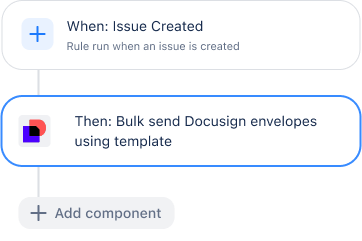Docusign integration for JSM
Integrated DocuSign with Jira Service Management to automate HR document workflows, reducing manual effort and improving efficiency in preboarding and approvals.
2025
Role
Product Designer
Team
Ana Vucinic, Michael Fedulov & Ivan Pang
Duration
Nov 2024- Jan 2025 (2 months)
The background
HR Spent 2.5 Hours Sending the Same Doc 80 Times—Now It’s All Done in a Click
Jira Service Management (JSM) has traditionally been recognised as a tool for IT teams, but its capabilities extend far beyond that. Expanding into HR Service Management (HRSM) presents a major opportunity to streamline critical HR processes, particularly in areas like recruitment, onboarding, and document management. One key challenge HR teams face is handling large volumes of documents—contracts, agreements, and compliance forms—efficiently. With the increasing demand for automated, integrated, and scalable solutions, there is a growing need to enhance JSM’s document management capabilities to better serve HR teams.
I led the product design for this integration, starting with a deep dive into ServiceNow’s Docusign Actions & Triggers and interviews with our People Ops team. The end result? A smooth, automated workflow that let HR send documents, populate fields, set signing orders, and personalise communication—without ever leaving JSM.
My contribution
The solution
Managing the scope
The DocuSign integration was planned as a multi-phase project with each stage introducing more advanced automation capabilities. I focused on the Seed phase, where the goal was to define and design the first meaningful action in JSM Automations.
The opportunity
Why HRSM, and Why Now?
When Atlassian identified a growing opportunity to serve HR teams more deeply within Jira Service Management (JSM), I was brought in to help design an e-signature integration for HR workflows. I reviewed internal business materials and a market assessment outlining how JSM could evolve into a stronger HR service management (HRSM) tool. This context helped me frame design decisions around both usability and positioning JSM as a credible HR platform—one that reduces manual document handling and boosts productivity. Seeing the bigger picture clarified the “why” and guided how I scoped the user journey.
market gap
HR leaders are interested in a consolidated service tool. By addressing HR capability gaps and buyer needs in the JSM product, we ignite wall-to-wall potential.
hr needs
Our challenge was to design an experience that balances HR sensitivity with the speed and structure of service management.
hr processes
HR processes felt impersonal and clunky—our goal was to make them feel simple and supportive.
The path
To shape the seed phase, I took a two-pronged approach:
🔍 Studied the competition
I analysed how platforms like ServiceNow automate HR document workflows, identifying features like bulk sending and smart templates that JSM was missing.
🔍 Spoke to our users
I interviewed People Ops to uncover where time and accuracy were slipping—manual form-filling, switching between tools, and redundant data entry.
💡 Mapped the gaps
I aligned competitor capabilities with our users' pain points, helping us pinpoint automation opportunities worth prioritising.
where we come in
Key insights revealed a demand for self-service and transparency—guiding our design to reframe JSM as a tool for clarity, not just ticketing.
Competitive Insights
COMPETITOR ANALYSIS
Platforms
2
Time
1 week
With over 25 actions, ServiceNow's integration with DocuSign automates document sending and retrieval, eliminating manual steps like storing data in systems like Google Sheets
Our competitor analysis focused on understanding how ServiceNow automates document workflows, particularly in HR document management. We examined YouTube demo videos and Servicenow documentation to analyse their approach to Docusign integration. This helped us identify key automation flows for handling offer letters, e-signatures, and user data collection, ensuring seamless information flow across different HR processes.
Competitor analysis shareback
-
Automated document management reduces manual work.
Seamless data integration between ServiceNow & DocuSign.
Event-triggered workflows for HR processes.
Pre-filled forms & reusable templates improve accuracy.
Bulk sending & tracking features enhance efficiency.
See more
-
Requires custom configuration for full automation.
Limited tracking for recipient-side interactions.
Manual user management slows onboarding.
Occasional system sync issues causing delays.
-
Implement pre-filled data fields to minimise errors.
Enable event-driven automation for document processing.
Automate notifications & tracking for better transparency.
Reduce manual work through AI-based data validation.
-
Introduce automated validation checks between systems.
Implement audit trails to improve compliance.
Remove repeated sign-ins for smoother user experience.
Enable mobile-friendly e-signing for accessibility.
-
Offer low-code/no-code integration to reduce IT reliance.
Improve bulk document handling and multi-party signing orders
Enhance real-time tracking & reporting for HR teams.
Focus on flexibility & customisation beyond ServiceNow’s rigid workflow.
Uncovering pain points
INTERVIEWS
Spotting automation opportunities
Participants
5
Time
60 minutes
We conducted interviews with the internal People Ops team to align DocuSign use cases with competitor capabilities and identify automation opportunities using JSM actions and triggers.
Inefficient Email Workarounds
To avoid rewriting contract emails, teams reuse the same predefined template, but this isn’t adaptable for different cases.
Validation Across Multiple Platforms
Once a document is signed, HR manually validates details across multiple systems like ICIMS & Workday, leading to delays or errors
Manual Data Entry & Storage
People Ops teams must manually enter and store employee data in Google Sheets, increasing the risk of errors and inconsistencies.
Repetitive Form-Filling
The same employee details need to be re-entered across multiple forms in editing softwares before being uploaded to Docusign.
DOCUSIGN WALKTHROUGH
By mapping pain points in tedious tasks, we pinpointed three key touchpoints—DocuSign, Microsoft Word, and iCIMS—that could be automated using smart values for seamless data integration and deferred employee information input at later stages.
Touchpoint A: Add field templates
At this point, People Ops is entering pre-hire details in Word, dragging and placing document fields for user input in DocuSign templates for each form they upload, and sending them to each recipient.
Touchpoint B: Signing order
People Ops must add recipients and configure the signing order for the envelope by entering recipient details such as name and email. However, these details can be replaced through smart values mapping in JSM, allowing them to simply specify the role receiving the template, which remains consistent based on the template’s use case.
Touchpoint C: Custom message
People Ops values personalised documents to enhance pre-boarding and onboarding. Customising preset email messages and subjects in JSM Automations was an exciting way to align with user needs and DocuSign capabilities.
Ideating the data journey between key systems
I sketched out flows to visualise how key HR data (like candidate name, manager, start date) could be pulled from JSM requests and pushed seamlessly into downstream tools like DocuSign and Workday. This helped clarify integration points and ensure the right data showed up in the right place at the right time.
Planning how smart values are mapped to DocuSign document fields
To enable automation, I mapped how smart values (Jira’s dynamic variables) would carry key info across systems. These values would be extracted from the JSM request put through by an HR agent with use cases varying from employee onboarding to bulk sending documents regarding org changes and embedded into document fields via webhooks or APIs — streamlining onboarding tasks without agents retyping a thing.
What we built
‘Sending Docusign Envelope using a template’ Modal States
The information section provides the admin with context on the application of this action’s functionality, supported by a link to community documentation page. The drop-down menu prompts users to select a preconfigured Docusign template from their template library
Action information
Closed/Expanded/Filled Documents
The document containers have three states: Closed, Expanded, and Filled. When a DocuSign template is selected, the attached PDF documents are retrieved from DocuSign. Fields that would normally require manual entry, such as the recipient's name or dates, are automatically pre-filled once the admin assigns smart values in the respective fields within the modal. This process transitions the document to the Filled state.
The "Confirm Details" section enables admins to review and further customise their envelopes with containers, including options to add recipients and edit the message. For adding recipients, the signing order and roles must be pre-determined in DocuSign, but fields like the recipient's name and email can be populated in the modal using smart values. This section is adaptable for multiparty signing scenarios, where the number of fields increases, and the field headers dynamically change based on the predetermined roles in DocuSign.
The "Edit Message" feature allows users to review and adjust the email subject and message, as all DocuSign envelopes are sent via email. Since these are text fields in JSM Automations, users can modify the message and subject, as well as add smart values such as names to personalise the emails, reflecting a common practice in similar use cases.
Confirm details
The prototype
Technical considerations
Initial design discussions with the engineering team have highlighted the following technical blockers:
A. Template mapping using an embedded integration
Similar to ServiceNow, do we need to create an embedded integration like Esignifi to facilitate template mapping and the flow of data between systems, especially for document attachments?
B. Pulling pre-written content
Can DocuSign information, such as pre-written email subjects and messages, flow into automations once a document is attached to the rule?
C. Comment Fields
Can preset email messages be displayed as comment fields on Jira Service Management, allowing smart values (e.g., recipient names) to be added on the go for a further personalised experience?
The outcome
The learnings
In this project, we aimed to identify the actions supported by competitors and prioritize use cases to alleviate the excessive hours HR agents spend during pre-onboarding. Through a competitive analysis of ServiceNow and internal interviews, we identified the first action, "send document to pre-hire," and uncovered valuable insights, such as the enthusiasm for bulk send actions and the importance of geo-location in shaping pre-onboarding automation rules. A key learning was the need to continuously iterate on design solutions based on internal team feedback, as this ensures a more adaptable and effective automation system.
This project pushed me to think beyond usability and UI polish. Digging into the business case for HRSM helped me build confidence in connecting product design with strategic value.
I realised how important it is to understand the broader market context when designing features—so that every interaction contributes meaningfully to the user goals. I also learned how to translate technical constraints (like smart values and component logic) into smoother, more intuitive interactions.
Here are some notes I took at the start to understand the project environment and over-arching team goals
Next steps
After setting up the initial action to send a DocuSign envelope via JSM Automations, the next steps involve automating further processes in the document management workflow.
First, a DocuSign envelope status update trigger will monitor changes in envelope status (e.g. completed, declined) and automatically progress related JSM
Next, a DocuSign bulk send action will enable batch processing of envelopes—ideal for scenarios requiring signatures from multiple recipients at once—boosting efficiency and consistency.
























